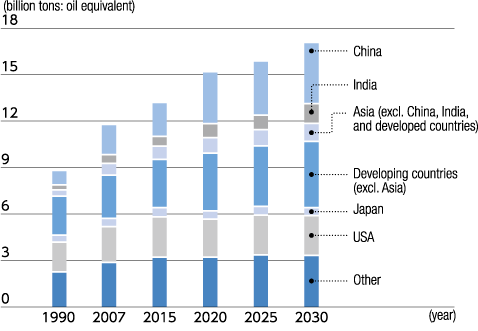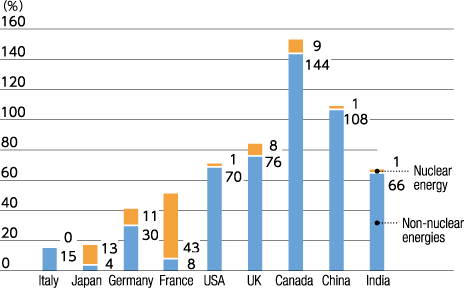The TEPCO Group bears an important mission to help realize a sustainable society through the stable supply of electricity.
TEPCO aims to achieve a good balance between "stability," "environmental performance," and "economic efficiency" over the long term, to respond to rapidly-changing economic and energy situations in Japan and around the world and secure stable electric power. We will systematically develop our power facilities so that we may respond flexibly to ever-changing energy demands and continue to deliver high-quality electricity in the future.
Global energy consumption is increasing yearly, particularly in developing countries, and is projected to increase about 40% between 2007 and 2030. There is growing concern that this drastic trend will eventually deplete the world's fossil energy resources, as well as increase CO2 emissions and cause fossil energy prices to soar on a global scale.
Worldwide primary energy consumption trends and outlook
 Source: Based on IEA, World Energy Outlook 2009
Source: Based on IEA, World Energy Outlook 2009
Japan's self sufficiency for energy is a mere 4%, and is substantially lower than other major developed countries. Even when nuclear power generation is considered a semi-domestically produced energy, the rate only increases to 17%, and still makes Japan roughly 80% dependent on imports. The stable procurement of energy resources is thus an extremely important issue to Japan.
Energy self-sufficiency of major countries
 (Note1) Imported and exported electric power is calculated as primary energy.
(Note1) Imported and exported electric power is calculated as primary energy.
(Note2) Figures may not sum to the total, due to rounding.
Source: Based on IEA, "Energy Balances of OECD/non-OECD Countries 2009 Edition"
If the world continues to produce energy at the current rate, petroleum resources are expected to run dry in 46 years, natural gas in 63 years, coal in 119 years, and uranium in 100 years.
Reserves of different energy resources
 Source for oil, natural gas and coal: BP, "BP Statistics 2010"
Source for oil, natural gas and coal: BP, "BP Statistics 2010"
Source for uranium: OECD-NEA/IAEA, "Uranium 2007"
© Tokyo Electric Power Company Holdings, Inc.